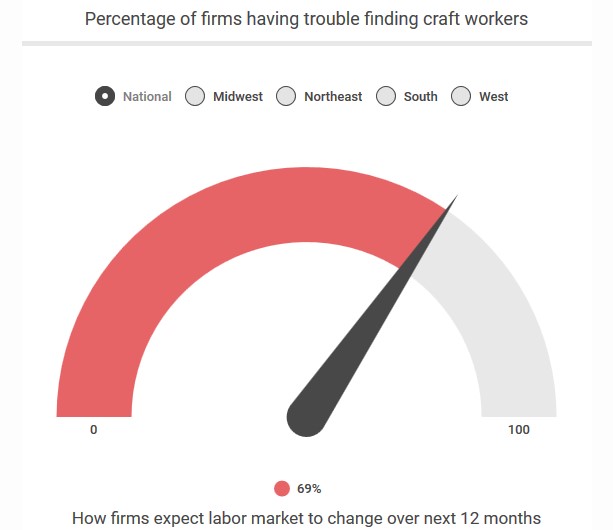Both Hillary Clinton and Donald Trump want to spur the economy by replacing crumbling highways, bridges, airports and transit systems.
Clinton has proposed a five-year, $275 billion plan that she boasts would create hundreds of thousands of new construction industry jobs, while Trump has vowed he would at least double Clinton’s proposal.
Related: Here’s Why It Will Be So Hard for Trump or Clinton to Rebuild America
“We will build the next generation of roads, bridges, railways, tunnels, seas ports and airports that our country deserves,” Trump said during a speech early this month to the Detroit Economic Club. “American cars will travel the roads, American planes will connect our cities, and American ships will patrol the seas. American steel will send new skyscrapers soaring.”
But even if the next administration and Congress were to move ahead with public works spending rivaling President Eisenhower’s interstate highway construction program launched in 1956, there may not be a large enough labor pool to meet the challenge, according to a new study.
The reality is that the construction industry already has all the work it can handle – and more – and may be woefully undermanned to meet the challenges of a major new national infrastructure initiative. A survey released on Wednesday by the Associated General Contractors of America finds that two-thirds of construction firms report having a hard time filling hourly craft positions that constitute the heart of the construction workforce.
“With the construction industry in most of the country now several years into a recovery, many firms have gone from worrying about not having enough work to not having enough workers,” said Stephen Sandherr, chief executive officer for the Associated General Contractors, in releasing the study. “These shortages have the potential to undermine broader economic growth by forcing contractors to slow scheduled work or choose not to bid on projects, thereby inflating the cost of construction.”
Related: The House Resorts to More Gimmicks to Pass $325 Billion Highway Bill
During a conference call with reporters, Sandherr sought to downplay the potential adverse effect of a skilled labor shortage on another round of major government infrastructure construction. He asserted that less skilled workers probably would be needed for many of those projects – especially highway and bridge construction – in contrast to other more complicated construction projects requiring bricklayers, sheet metal workers, electricians and plumbers.
“For a lot of workers who perform that type of work, there is not a requirement for the higher skills that exists on the building side of the house,” he said. “We don’t anticipate a shortage of workers in that area if by chance there was a sudden spike in infrastructure spending.”
Yet Trump and Clinton both were discussing far more challenging public works projects than simply highway paving projects, including new transit systems, tunnels, sea port and air ports, that clearly would require large numbers of highly skilled workers.

Source: Associated General Contractors of America
Of the nearly 1,500 respondents to the general contractors group’s survey, 69 percent said they were having trouble filling hourly craft positions. Those shortages are most severe in Midwestern states, where 77 percent of contractors say they are having a hard time filling those positions. The problem is nearly as bad in the South, where 74 percent of contractors say they are suffering severe labor shortages, and in the West, where 71 percent are experiencing similar problems.
Industry officials marvel at the dramatic transformation in the construction field, with the skilled labor shortages putting upward pressure on hourly wages and forcing some contractors to recruit less skilled or even poorly trained workers. In the depths of the Great Recession, the unemployment rate in the construction industry in June 2010 was 20.1 percent, with well more than a million construction workers without jobs. Yet in June of this year, construction industry unemployment was down to just 4.6 percent -- the lowest it has been since 2000.
Among the firms that responded to the survey, nearly a third perform highway construction work and 50 percent work on public buildings. These are the types of companies that the government would be relying on if it were to undertake a new round of infrastructure stimulus spending.
The shortages of skilled labor have forced nearly half of the construction companies surveyed to increase the base pay for crafts workers. Beyond that, companies are complaining about a dearth of construction professionals, such as supervisors and in-office staff who are responsible for making cost estimates and creating computerized models.
Related: Obama’s Big Pitch for Infrastructure Falls Short
Company officials also say they worry about a shortage of government and private training programs to help get more qualified workers into the pipeline. As a result, they say, skilled workers are being required to work overtime, or employers are taking a chance by using less skilled labor, which can result in shoddy workmanship or serious accidents on work sites.
Sandherr urged federal, state and local officials to outline proposals for coping with the growing labor shortage. For instance, he urged Congress to increase funding for the Perkins Career and Technical Education Act, enact immigration reform to open the borders to more skilled workers and to make it easier to set up charter schools and career academies that teach basic construction skills.
The contractors’ warnings that the industry might not be up to the challenge of a new round of public works projects has been met with skepticism in some quarters. Ray LaHood, the former Obama administration transportation secretary and now co-chair of the highway advocacy group Build America’s Future, believes the construction industry could absorb the increased work.
Citing the situation in his home state of Illinois, LaHood said in an interview Wednesday that “when I talk to the building trades folks back here, they still believe that the highest unemployment sector is the building trades, and that if there was a big infrastructure bill, or a large chunk of money, that they would be able to provide the kind of workers needed.”
Related: Experts Warn Trump and Clinton of a Big Threat to the Economy
“They believe the work force is not lacking in terms of skilled folks to build roads and redo bridges,” he added. “They’re hoping that either one of these candidates [Trump or Clinton] will fulfill their obligation to come forward with a big infrastructure bill.”





